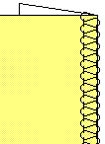Without a machine that actually HAS a flatlock stitch, you can still create your own with this tip!
Ever try and get a consistent flat-lock stitch with your serger? Do you have a model of serger that does not allow you to remove the blades? Or one that can only go down to three threads? Do you absolutely HATE messing around with the tension dials?
If this is you, then try this method for a "cheater" version of the flatlock stitch.
Flatlocking is serging two layers of fabric together, then pulling them apart until the seam lies flat. It takes experimentation to get the tension just right. Too loose a tension and the seam pulls away, too tight and you can't get it to lay flat.
This is my version of flatlocking. It's not the same but it works for me.
- Method 1 is used in areas where there is a seam.
- Method 2 is for surface decoration.
Just as in normal flatlocking, fabrics that work best are knits, sweatshirting or polar fleece. These fabrics have a more stable edge. Woven fabrics can be "fake" flatlocked successfully if you shorten the stitch length so your serging is denser. Try using a decorative thread in the upper looper for a well-filled stitch.
|
Method 1 |
 |
|
|
Place the two serged edges together, then using a zig-zag stitch, sew the two sides together. |
||
|
Your fake flatlocked seam will be considerably wider than normal flatlocking, but I think the trade off is worth the ease of completion. |
 |
|
|
Method 2 |
||
|
Serge a folded edge of your fabric, being careful not to cut through the fold. |
 |
|
|
 |
